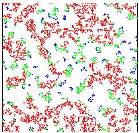
Click on the image for a
larger picture
Back to MAIN PAGE
Persistence of Fluctuations

Click on the image for a
larger picture
One can pose persistence type of questions in the context of surface fluctuations as well: what is the probability that a particular structure (e.g., a certain mound) will keep its identity (of being a mound) for a given period of time t? To illustrate the complexity of the physics of persistence, let us perform a simple numerical experiment: On a two dimensional substrate we initially prepare a rough surface by choosing the height at each site randomly from a Gaussian distribution with zero mean, and then we let it evolve through the diffusion equation. During the dynamics we keep track of the persistent sites, i.e., sites at which the deviation of the height from its mean (i.e. from zero) did not change sign up to a given time t. If a fluctuation changes the sign of the height (measured as the deviation from its mean) at a site before, or at time t, we simply discard that site from that moment on. The Figure above displays in the unit square the distribution of persistent sites that had the height variable above the mean interface height at all times up to t1 (red+green+blue), t2 > t1 (red+green), and t3 > t2 (red). Note, that in spite of the simplicity of the dynamics, the generated sets have complex structures, that appear to be fractal. The Haussdorff dimension of the persistent set is D = 1.5 in contrast to the initial configuration which is area filling, i.e., it has a geometrical dimension of Do = 2 .
As the system evolves in time, fewer and fewer sites remain persistent, and the total number of persistent sites decays according to a power law N(t)~t-s, where s is the so called persistence exponent. For the simple dynamics model described above its value has been determined numerically (S.N. Majumdar, C. Sire, A.J. Bray, and S. Cornell Phys.Rev.Lett. 77 2867 (1996)) with great precision to be s=0.1875(10) (for one dimensional substrates: s= 0.1207(5)). The apparent simplicity of the dynamics motivated extensive work to find a rigorous derivation of the exponent, so far without success. There are theories able to approximate the value of s with great accuracy, but their systematic improvement seems to fail, and an exact, closed-form expression is still missing. In this respect, let us quote here s (for two dimensional substrate) from the approximate theory presented in Ref. 2) below: s= (4-p)/(4p-8) = 0.1879..., obtained by exploiting the notion of sign-time distributions. Our approach is based on an Ansatz that is yet to be proved (or disproved). The above expression for s suggests that the persistent exponents may in fact be irrational, even transcendental numbers, a property rarely encountered among the classical exponents of simple statistical models. For an extensive list on persistence exponents obtained numerically for various linear interface growth models, see: J. Krug, H. Kallabis, S. N. Majumdar, S. J. Cornell, A. J. Bray and C. Sire, Phys. Rev. E 56 2702 (1997).
1) Z. Toroczkai, T. J. Newman and S. Das Sarma, Sign-time distributions for interface growth, Phys. Rev. E 60, R1115 (1999)
2) T. J. Newman and Z. Toroczkai, Diffusive persistence and the "sign-time" distribution, Phys. Rev. E 58, R2685 (1998)